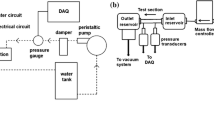Abstract
Two-phase parallel flow can be utilized in microreactor engineering for performing reactions and extractions, and also for achieving efficient phase separation at the exit of the microreactor. Typical laminar flow at the microscale allows two phases to flow in parallel without mixing, allowing highly controlled conditions for a specific chemical process. Since the liquid with the higher viscosity has a tendency to occupy a larger fraction of the microchannel, the position of the interface can be controlled through the adjustment of flow rates. The prediction of the position of the interface is important for microreactor design and operation and requires the solution of the governing equations of fluid mechanics. In this work, the theoretical description for two-phase parallel flow, based on the Navier–Stokes equations in three dimensions was expressed with a mathematical model and validated with experimental observations. The movement of the interface was achieved through the adjustment of fluid properties according to the position of the central streamlines. The predicted position of the interface was in good agreement with experimental data. A correlation for the flow rate ratio required for positioning the interface in the middle of the channel for various viscosity ratios was proposed, as well as a correlation for the prediction of the parallel to slug transition for a water/n-hexane system.











Similar content being viewed by others
Abbreviations
- Bo :
-
Bond number (–)
- Ca :
-
Capillary number (–)
- D h :
-
Hydraulic diameter (m)
- g :
-
Standard gravity (m/s2)
- H :
-
Microchannel height (m)
- Kn :
-
Knudsen number (–)
- L :
-
Microchannel length (m)
- p :
-
Pressure (Pa)
- R 1 :
-
Radius of curvature (m)
- R 2 :
-
Radius of curvature (m)
- Re :
-
Reynolds number (–)
- Re c :
-
Critical Reynolds number (–)
- t :
-
Time (s)
- u :
-
Velocity in the x direction (m/s)
- uvw :
-
Overall flow field (m/s)
- v :
-
Velocity in the y direction (m/s)
- w :
-
Velocity in the z direction (m/s)
- \( \bar{w}_{\text{h}} \) :
-
Average velocity of n-hexane at the inlet to the central channel (m/s)
- \( \bar{w}_{\text{w}} \) :
-
Average velocity of water at the inlet to the central channel (m/s)
- W :
-
Microchannel width (m)
- We :
-
Weber number (–)
- γ:
-
Interfacial tension (N/m)
- μ :
-
Viscosity (Pa s)
- ρ :
-
Density (kg/m3)
- τ :
-
Artificial compressibility (s m/kg)
- Φ 1 :
-
Flow rate of one phase (m3/s)
- Φ 2 :
-
Flow rate of the other phase (m3/s)
References
Aljbour S, Yamada H, Tagawa T (2009) Simultaneous reaction–separation in a microchannel reactor with the aid of a guideline structure. Int J Chem Biol Eng 2:220–223
Andreson JD Jr (1995) Computational fluid dynamics—the basics with applications. McGraw-Hill, New York
Cheng P, Wu HY (2006) Mesoscale and microscale phase-change heat transfer. Adv Heat Transf 39:461–563
Galambos P, Forster F (1998) An optical micro-fluidic viscometer. International Mechanical Engineering Congress and Exposition, Anaheim. http://www.mendeley.com/research/optical-microfluidic-viscometer/
Guillot P, Colin A (2005) Stability of parallel flows in a microchannel after a T junction. Phys Rev E 72:066301
Guillot P, Moulin T, Kotitz R, Guirardel M, Dodge A, Joanicot M, Colin A, Bruneau CH, Colin T (2008) Towards a continuous microfluidic rheometer. Microfluid Nanofluid 5:619–630
Hibara A, Tokeshi M, Uchiyama K, Hisamoto H, Kitamori T (2001) Integrated multilayer flow system on a microchip. Anal Sci 17:89–93
Hitt DL, Macken N (2004) A simplified model for determining interfacial position in convergent microchannel flows. J Fluids Eng 126:758–768
Kashid M, Kiwi-Minsker L (2011) Quantitative prediction of flow patterns in liquid–liquid flow in micro-capillaries. Chem Eng Process. doi:10.1016/j.cep.2011.07.003
Kashid MN, Renken A, Kiwi-Minsker L (2011) Influence of flow regime on mass transfer in different types of microchannels. Ind Eng Chem Res 50:6906–6914
Lu Y, Xia Y, Luo G (2011) Phase separation of parallel laminar flow for aqueous two phase systems in branched microchannel. Microfluid Nanofluid 10:1079–1086
Münchow G, Hardt S, Kutter JP, Drese KS (2007) Electrophoretic partitioning of proteins in two-phase microflows. Lab Chip 7:98–102
Pohar A, Plazl I (2008) Laminar to turbulent transition and heat transfer in a microreactor: mathematical modeling and experiments. Ind Eng Chem Res 47:7447–7455
Pohar A, Plazl I, Žnidaršič Plazl P (2009) Lipase-catalyzed synthesis of isoamyl acetate in an ionic liquid/n-heptane two-phase system at the microreactor scale. Lab Chip 9:3385–3390
Tamamidis P, Zhang G, Assanis DN (1996) Comparison of pressure-based and artificial compressibility methods for solving 3D steady incompressible viscous flows. J Comput Phys 124:1–13
Zhao Y, Chen G, Yuan Q (2006) Liquid–liquid two-phase flow patterns in a rectangular microchannel. AIChE J 52:4052–4060
Žnidaršič-Plazl P, Plazl I (2007) Steroid extraction in a microchannel system—mathematical modeling and experiments. Lab Chip 7:883–889
Žnidaršič-Plazl P, Plazl I (2009) Modelling and experimental studies on lipase-catalyzed isoamyl acetate synthesis in a microreactor. Process Biochem 44:1115–1121
Author information
Authors and Affiliations
Corresponding author
Rights and permissions
About this article
Cite this article
Pohar, A., Lakner, M. & Plazl, I. Parallel flow of immiscible liquids in a microreactor: modeling and experimental study. Microfluid Nanofluid 12, 307–316 (2012). https://doi.org/10.1007/s10404-011-0873-7
Received:
Accepted:
Published:
Issue Date:
DOI: https://doi.org/10.1007/s10404-011-0873-7



